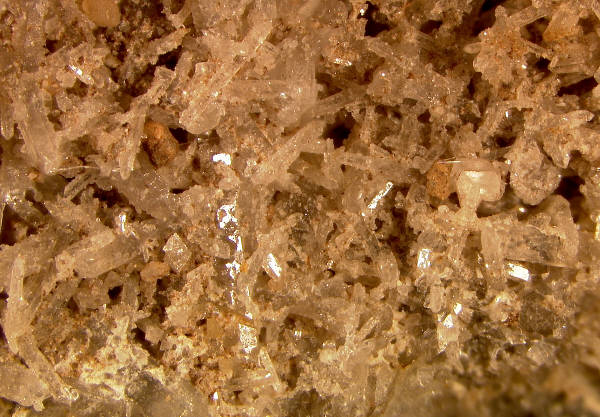The best website on "Herkimer Diamonds"
People who study ore deposits, and the minerals with them, may recognize some features common to fault controlled mineralization. The argument here, and presented on the theory web page, is that Herkimer diamonds are in part formed from fault controlled hydrothermal fluids. But what has been elusive over the years is some sort of field evidence.
On this page will be presented, or at least proposed, evidence to support the theory that hydrothermal fluids did move up along faults and leave behind "clues" of their behavior.
When I first started this study to do research on Herkimer diamonds I was puzzled by the different "stories" people were giving about how they came to be formed. Many of these diverse stories are still in circulation today. Having seen many ore deposits around the globe, and having been trained as a research geologist, it seemed like "The History of Herkimer Diamonds" would be a fun project to tackle.
Almost everyone agreed that the layers of dolomite bearing rock had some influence on the Herkimer diamonds because that is where they were found. But what also seemed clear is that the mines were located next to "escarpments", or faults. It also was observed that the further you moved away from the fault (perpendicular to it) the less likely you were to find a high frequency of mineralization (although true only on a large scale). There was also laboratory evidence that 200 degree Celius fluids were involved, and both uranium and platinum were found in the black hydrocarbon material.
Now, the big question, was there any field evidence? Something I could photograph?
Hydrothermal Features in Herkimer diamond mines

Sometimes luck plays a role in science. This "druze" photo from the TCR site is located on the druze page, but it is quite unusual for the Herkimer district. Frankly, I was very surprided to see it and it reminded me of the quartz from Ellenville, NY (few would dispute that mine's hydrothermal, fault controlled origin).
In addition this unique druze overlies, and etches, an earlier druze.
But one sample does not make a convincing argument. While at the DA site I had seen this bleached white rock that was very porous, and light - like pumice stone. It reminded me of the altered rock I had seen at other hydrothermal mines. The picture (2009) to the left is of this rock , 3 to 4 feet long, and was bulldozed up during the use of heavy equipment (scratch marks easily seen on the bottom left). Definately a "throw away" and of little interest to anyone but me (probably).
It no longer looks like a blocky or layered gray limestone - brown dolostone. It sort of looks like someone poured acid all over it. Through a microscope it might look as shown below.

And then there was this rock. It is basically saturated with quartz and the host rock is partially gone. It was collected at the TCR site (2009), with permission of the owner. The picture to the left, taken 2010) is 6 cm across. Again it is unusually light, and definately a "throw away" .
Below is a close-up. Notice the holes everywhere and the grey/white silica is basically holding the stone together. Something disolved away the rock.

The mine owner at the TCR site (2009), told me of specimens that were extremely light, lifted with one hand easily. When bathed in oxalic acid the result was a light skelton, or open network, of quartz veinlets and nothing else. A specimen of such was kindly donated by the mine owner and is shown inthe photograph below. Again, something had disolved away all the host rock leaving behind a quartz "skeleton". 6 cm across, photo by Dr. D. 2010.
What caused this to happen?

Geology is much like solving a mystery. We can not go back in time and see exactly what happened. Instead what we can do is piece together clues and construct a theory about what happened. Hopefully the theory is a good fit for all the clues.
But science is always changing and technology advances. New evidence can appear at any time whch will require us to modify the theory.
If you have any evidence, please send it along with a photo if possible.
It may be hard to imagine fluids moving through solid rock. Often the vertical movement is along cracks and many of the mines show cracks that have mineral, and/or, hydrocarbon coatings (see the druze page). But the horizontal flow is a bit harder to visualize. The microscope photo to the right is an example of what the porous rock might have looked like prior to the introduction of mineral bearing fluids (like what we see in the next few photos). What is probably important in the Herkimer district is that only some layers have this high degree of porosity, and thus some layers have minerals.
It is also likely that the porosity changed during the multiple episodes of fluid movement, as shown below.


As a final note - some breccia (cracked and cemented rock) can be evidence for hydrothermal fluid action. But what is likely to have happened in the Herkimer mining district is a combination of vertial flow up along fault features and horizontal flow along porous sedimentary beds. As the research unfolds we expect to find more evidence to support this hypothesis.
If you have any field evidence please send us a photo, or a rock sample.